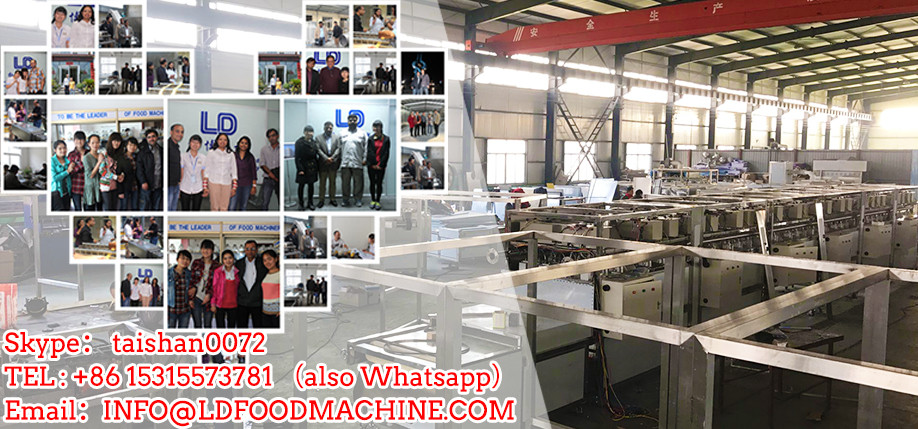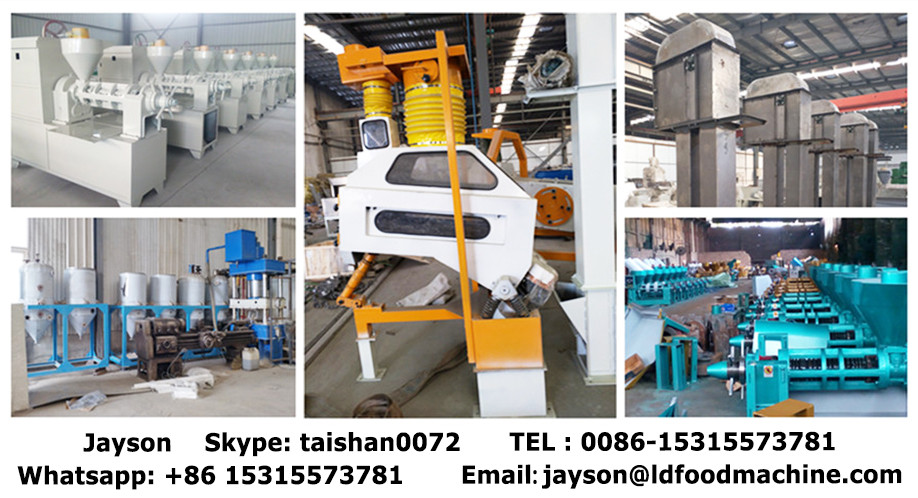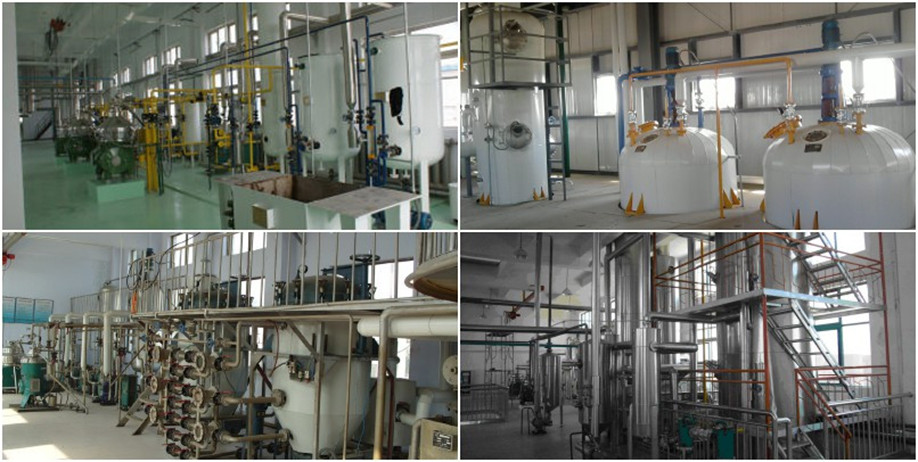Fully continuous process for waste corn oil to biodiesel production machine


Raw materials for biodiesel production
1. Vegetable oils
• Castor oil, lower cost than many candidates. Kinematic viscosity may be an issue.
• Coconut oil (copra oil), promising for local use in places that produce coconuts.
• Colza oil, from Brassica rapa, var. oleifera (turnip) is closely related to rapeseed (or canola) oil. It is a major source of biodiesel in Germany.
• Corn oil, appealing because of the abundance of maize as a crop.
• Cottonseed oil, the subject of study for cost-effectiveness as a biodiesel feedstock.
• False flax oil, from Camelina sativa, used in Europe in oil lamps until the 18th century.
• Hemp oil, relatively low in emissions. Production is problematic in some countries because of its association with marijuana.
• Mustard oil, shown to be comparable to Canola oil as a biofuel.
• Palm oil, very popular for biofuel, but the environmental impact from growing large quantities of oil palms has recently called the use of palm oil into question.
• Peanut oil, used in one of the first demonstrations of the Diesel engine in 1900.
• Radish oil. Wild radish contains up to 48% oil, making it appealing as a fuel.
• Rapeseed oil, the most common base oil used in Europe in biodiesel production.
• Ramtil oil, used for lighting in India.
• Rice bran oil, appealing because of lower cost than many other vegetable oils. Widely grown in Asia.
• Safflower oil, explored recently as a biofuel in Montana.
• Salicornia oil, from the seeds of Salicornia bigelovii, a halophyte (salt-loving plant) native to Mexico.
• Soybean oil, not economical as a fuel crop, but appealing as a byproduct of soybean crops for other uses.
• Sunflower oil, suitable as a fuel, but not necessarily cost effective.
• Tigernut oil has been described by researchers in China as having "great potential as a biodiesel fuel."
• Tung oil, referenced in several lists of vegetable oils that are suitable for biodiesel. Several factors in China produce biodiesel from tung oil.
2. Animal fats
Animal fats including tallow, lard, yellow grease, chicken fat, and the by-products of the production of Omega-3 fatty acids from fish oil.
3. Animal and vegetable oil mixture
4. Waste oil
Waste cooking oil, illegal cooking oil, hogwash oil and so on.
Biodiesel production process
1. Feedstock pretreatment
Common feedstock used in biodiesel production, include yellow grease (recycled vegetable oil), “virgin” vegetable oil, and tallow. Recycled oil is processed to remove impurities from cooking, storage, and handling, such as dirt, charred food and water. Virgin oils are refined, but not to a food-grade level. Degumming to remove phospholipids and other plant matter is common, though refinement processes vary.
Regardless of the feedstock, water is removed as its presence during base-catalyzed transesterification causes the triglycerides to hydrolyze, giving salts of fatty acids(soaps) instead of producing biodiesel.
2. Determination and treatment of free fatty acids
A sample of the cleaned feedstock oil is titrated with a standardized base solution in order to determine the concentration of free fatty acids (carboxylic acids) present in the vegetable oil sample. These acids are then either esterified into biodiesel, esterified into glycerides, or removed, typically through neutralization.
3. Reactions
Base-catalyzed transesterification reacts lipids (fats and oils) with alcohol (typically methanol or ethanol) to produce biodiesel and an impure coproduct, glycerol. If the feedstock oil is used or has a high acid content, acid-catalyzed esterification can be used to react fatty acids with alcohol to produce biodiesel. Other methods, such as fixed-bed reactors, supercritical reactors, and ultrasonic reactors, forgo or decrease the use of chemical catalysts.
4. Product purification
Products of the reaction include not only biodiesel, but also byproducts, soap, glycerol, excess alcohol, and trace amounts of water. All of these byproducts must be removed to meet the standards, but the order of removal is process-dependent.
The density of glycerol is greater than that of biodiesel, and this property difference is exploited to separate the bulk of the glycerol coproduct. Residual methanol is typically recovered by distillation and reused. Soaps can be removed or converted into acids. Residual water is also removed from the fuel.
Outputs of biodiesel production
1. Biodiesel
Biodiesel is a renewable, clean-burning diesel replacement that is reducing our dependence on foreign petroleum, creating jobs and improving the environment. Made from a diverse mix of feedstocks including recycled cooking oil, soybean oil, and animal fats, it is the first and only EPA-designated Advanced Biofuel in commercial-scale production. Meeting strict technical fuel quality and engine performance specifications, it can be used in existing diesel engines without modification and is covered by all major engine manufacturers’ warranties, most often in blends of up to 5 percent or 20 percent biodiesel.
Constantly production of biodiesel would significantly lessen our dependence on imported oil, bolstering national security and reducing our trade deficit. At the same time, biodiesel’s growth would boost the economy, not just by creating jobs but also by reducing our dependence on global oil markets and vulnerability to price spikes. The industry’s economic impact is poised to grow significantly with continued production increases. The industry supports jobs in a variety of sectors, from manufacturing to transportation, agriculture and service.
The EPA has recognized biodiesel’s environmental benefits by classifying it as an Advanced Biofuel, making biodiesel the only commercial-scale fuel produced to meet the agency’s advanced criteria. According to the EPA, biodiesel reduces greenhouse gas emissions by at least 57 percent and up to 86 percent when compared to petroleum diesel – making it one of the most practical and cost-effective ways to immediately address climate change. In addition, biodiesel sharply reduces major tailpipe pollutants from petroleum diesel, particularly from older diesel vehicles. This is important because the EPA has consistently cited diesel exhaust – primarily from older trucks, buses and other vehicles – as one of the nation's most dangerous pollutants.
2. Glycerin
It is a byproduct of the production of biodiesel via transesterification. The glycerin directly from the production is crude, it’s can be purified. The purified glycerin can be widely used in food and cosmetic industry.
Technical indicators of finished biodiesel
Items |
Value |
|
Density(20℃)/(KG/M³) |
820-900 |
|
Kinematic viscosity(20℃)/mm²/S) |
3.0-8.0 |
|
Closed-cup flash point (℃) |
≥ |
130 |
Cold filter plugging point (℃) |
≤ |
|
Sulphur content (%) |
≤ |
0.05% |
Carbon residue on 10% residuum (%) |
≤ |
0.3 |
Sulfated Ash (%) |
≤ |
0.02 |
Moisture (%) |
≤ |
Water mark |
Mechanical impurities |
No |
|
Copper corrosion |
≤ |
Level 1 |
Cetane number |
≥ |
49 |
Oxidation stability(110℃)/ h |
≥ |
6/Addtives |
Acid value(mgKOH/g) |
≤ |
0.8 |
Free glycerol content (%) |
≤ |
0.02 |
Total glycerin content (%) |
≤ |
0.24 |
90% recovered temperature (℃) |
≤ |
360 |
Biodiesel production plant presentation


Visiting customers presentation


Why choose us?
1. We have 9 years experiences in the machinery market, 5 years domestic trade, 4 years freign trade.
2.. Provide you the high quality biodiesel plant with the best raw materials and the unique technology.
3.. Professionally explain your questions and service warm thorough.
4. Exported to almost 30 countries, have customers all over the world.
5. Certificated by ISO, CE, SGS, BV, TUV, EPA
6. After service provided and engineers available to overseas help you with the installation and commisssioning of the biodiesel plant.
7. One year warranty for free.
Jinan Joysun Machinery Co., Ltd. Fully continuous process for waste corn oil to biodiesel production machine a les avantages de la haute pression, du rendement élevé d'huile, de la structure compacte et du chauffage commandé. En outre, Fully continuous process for waste corn oil to biodiesel production machine est non seulement très efficace et économe en énergie, mais aussi respectueux de l'environnement et propre. est facile et sûr à utiliser la presse à huile, ce qui réduit considérablement l'intensité du travail. peut être largement utilisé dans le pressage des plantes oléagineuses comme le sésame, le soja, l'arachide, le lin, le noyau de noix, le noyau d'amande et le pignon de pin (l'enlèvement de la peau aura un meilleur effet).
Jinan Joysun Machinery Co., Ltd. est une société de commerce international dédiée à tous les types d'équipements. Nos machines sont hautement automatisées, écologiques et écoénergétiques. Jinan Joysun Machinery Co., Ltd. Avec plus de 200 brevets nationaux de propriété intellectuelle, avec une équipe de supervision de qualité professionnelle et un système de gestion saine. L'équipement de raffinage est une nouvelle industrie, de nombreuses entreprises n'ont pas de normes de qualité, et nous avons élaboré un ensemble de normes de l'industrie, et les organismes de réglementation pertinents pour le record. Nous avons une salle de support complets, y compris CNC, CNC machine à cintrer, conformément aux normes de sécurité électrique GB5226.